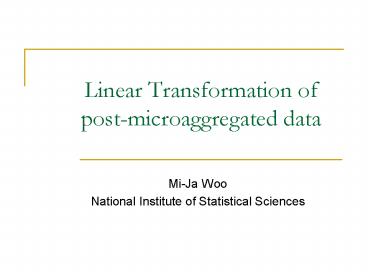Linear Transformation of post-microaggregated data - PowerPoint PPT Presentation
1 / 11
Title:
Linear Transformation of post-microaggregated data
Description:
Linear Transformation of post-microaggregated data Mi-Ja Woo National Institute of Statistical Sciences Motivation: Example Different distributions, but the same ... – PowerPoint PPT presentation
Number of Views:35
Avg rating:3.0/5.0
Title: Linear Transformation of post-microaggregated data
1
Linear Transformation of post-microaggregated
data
- Mi-Ja Woo
- National Institute of Statistical Sciences
2
Motivation Example
3
- Different distributions, but the same moments
and estimates of regression coefficients. - How about making D3 have the same mean and
covariance?
4
1. Linear Transformation
- Let D1 be the original p-dimensional data with
mean, E1 and covariance matrix S1. - Let D2 be the post-microaggregated p-dimensional
data with mean, E2 and covariance matrix, S2. - Transform D2 into T(D2) such that ET(D2)E1
ST(D2)S1.
5
How to compute A and b?
- Mathematically, A and b are obtained as
. - Use SVD decomposition to calculate
6
NOTES
- Linear transformed masked data yields the same
analysis based on mean and covariance. - How about higher moments? There is no clear
answer, but higher moments rely on distributions
other than A, b, mean and covariance. We
need data utility measures. - Linear transformation does not preserve
positivity. - Can we improve data utility of other SDLs through
linear transformation?
7
Question Other masked data?
8
Linear transformation with constraint of
positivity.
- Partition X into
- Transform X2 but not X1.
- Replace final negative values with minimum of
original data or zero after transforming X2. - It is the middle of non-transformed
microaggregated and transformed microaggregated
data. - The utility of this method depends on how many
negative values are in transformed
microaggregated data.
9
How to partition X?
- The way of partitioning X1. Initially,
transform X in YAXb.2. Sort Y according to
descending order.3. Count how many records are
negative, n. 4. Partition Y into Y1 and Y2,
where Y1 has 1st to (n np)-th observations of
Y and Y2 contains the rest of them.5. Partition
X in X1 and X2 corresponding to Y1 and Y2. - More observations are added to Y1 in order to
reduce the possibility of getting negative values
after transforming X2.
10
Example
- Here are eight different types of data.
- For most of data violating signs, the procedure
above improves utilities. - Since it is the middle of non-transformed and
transformed microaggregated data, it does not
always improve three data utilities comparing to
transformed microaggregated data. - Improvement of Non-symmetric Low Positive is the
largest, that of Non-symmetric High Positive is
the next, and the last one is Non-symmetric Low
Negative.
11
END































